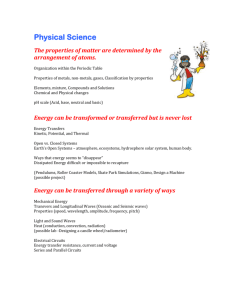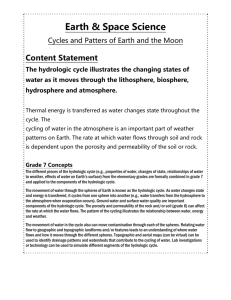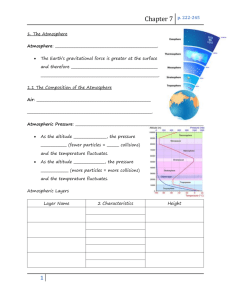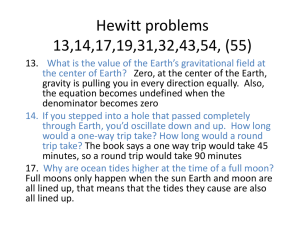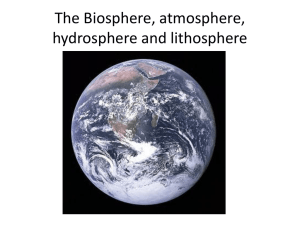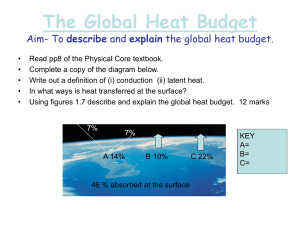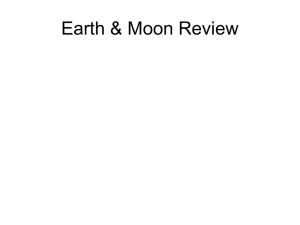Science 7th Grade Pacing Chart
advertisement
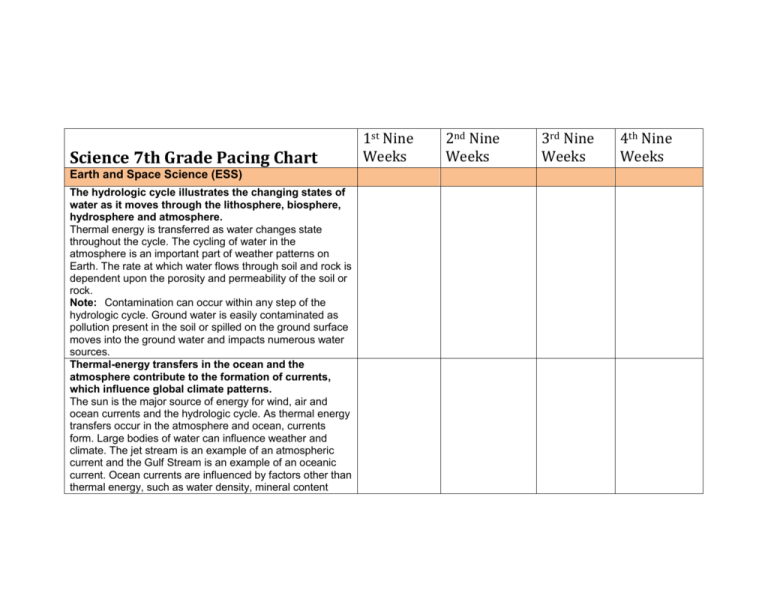
Science 7th Grade Pacing Chart Earth and Space Science (ESS) The hydrologic cycle illustrates the changing states of water as it moves through the lithosphere, biosphere, hydrosphere and atmosphere. Thermal energy is transferred as water changes state throughout the cycle. The cycling of water in the atmosphere is an important part of weather patterns on Earth. The rate at which water flows through soil and rock is dependent upon the porosity and permeability of the soil or rock. Note: Contamination can occur within any step of the hydrologic cycle. Ground water is easily contaminated as pollution present in the soil or spilled on the ground surface moves into the ground water and impacts numerous water sources. Thermal-energy transfers in the ocean and the atmosphere contribute to the formation of currents, which influence global climate patterns. The sun is the major source of energy for wind, air and ocean currents and the hydrologic cycle. As thermal energy transfers occur in the atmosphere and ocean, currents form. Large bodies of water can influence weather and climate. The jet stream is an example of an atmospheric current and the Gulf Stream is an example of an oceanic current. Ocean currents are influenced by factors other than thermal energy, such as water density, mineral content 1st Nine Weeks 2nd Nine Weeks 3rd Nine Weeks 4th Nine Weeks (such as salinity), ocean floor topography and Earth’s rotation. All of these factors delineate global climate patterns on Earth. Note: This content statement is related to LS grade 7 (biomes). Regional temperature and precipitation contribute to the identification of climatic zones. The atmosphere has different properties at different elevations and contains a mixture of gases that cycle through the lithosphere, biosphere, hydrosphere and atmosphere. The atmosphere is held to the Earth by the force of gravity. There are defined layers of the atmosphere that have specific properties, such as temperature, chemical composition and physical characteristics. Gases in the atmosphere include nitrogen, oxygen, water vapor, carbon dioxide and other trace gases. Biogeochemical cycles illustrate the movement of specific elements or molecules (such as carbon or nitrogen) through the lithosphere, biosphere, hydrosphere and atmosphere. Note: The emphasis is on why the atmosphere has defined layers, not on naming the layers. The relative patterns of motion and positions of the Earth, moon and sun cause solar and lunar eclipses, tides and phases of the moon. The moon’s orbit and its change of position relative to the Earth and sun result in different parts of the moon being visible from Earth (phases of the moon). A solar eclipse is when Earth moves into the shadow of the moon (during a new moon). A lunar eclipse is when the moon moves into the shadow of Earth (during a full moon). Gravitational force between the Earth and the moon causes daily oceanic tides. When the gravitational forces from the sun and moon align (at new and full moons) spring tides occur. When the gravitational forces of the sun and moon are perpendicular (at first and last quarter moons), neap tides occur. Life Science (LS) Matter is transferred continuously between one organism to another and between organisms and their physical environments. Plants use the energy in light to make sugars out of carbon dioxide and water (photosynthesis). These materials can be used and immediately stored for later use. Organisms that eat plants break down plant structures to produce the materials and energy they need to survive. Then they are consumed by other organisms. Energy can transform from one form to another in living things. Animals get energy from oxidizing food, releasing some of its energy as heat. The total amount of matter and energy remains constant, even though its form and location change. Note 1: Chemical reactions are resented as the rearrangement of atoms in molecules. Note 2: Chemical reactions in terms of subatomic structures of atoms are not appropriate. In any particular biome, the number, growth and survival of organisms and populations depend on biotic and abiotic factors. Biomes are regional ecosystems characterized by distinct types of organisms that have developed under specific soil and climatic conditions. The variety of physical (abiotic) conditions that exists on Earth gives rise to diverse environments (biomes) and allows for the existence of a wide variety of organisms (biodiversity). Ecosystems are dynamic in nature; the number and types of species fluctuate over time. Disruptions, deliberate or inadvertent, to the physical (abiotic) or biological (biotic) components of an ecosystem impact the composition of an ecosystem. Note: Predator-prey and producer consumer relations are addressed in grade 5. Physical Science (PS) The properties of matter are determined by the arrangement of atoms. Elements can be organized into families with similar properties, such as highly reactive metals, less-reactive metals, highly reactive nonmetals and some gases that are almost completely nonreactive. Substances are classified according to their properties, such as metals and acids. When substances interact to form new substances, the properties of the new substances may be very different from those of the old, but the amount of mass does not change. Note 1: This is the conceptual introduction of the Periodic table of Elements. Note 2: Acids and bases are included in this topic; further detail will be provided in the Model Curriculum. Note 3: It is important to emphasize that most changes in the properties of matter have some combination of chemical and physical change (at different levels). Energy can be transformed or transferred but is never lost. When energy is transferred from one system to another, the quantity of energy before transfer equals the quantity of energy after transfer. When energy is transformed from one form to another, the total amount of energy remains the same. Note: Further discussion of energy transformation is addressed at the high school level. Energy can be transferred through a variety of ways. Mechanical energy can be transferred when objects push or pull on each other over a distance. Electromagnetic waves transfer energy when they interact with matter. Thermal energy can be transferred through radiation, convection and conduction. Electrical energy transfers when an electrical source is connected in a complete electrical circuit to an electrical device. Note 1: Energy transfers should be experiential and observable. This builds upon PS grade 4 and is directly connected to ESS grade 7 (thermal energy transfers in the hydrologic cycle). Note 2: Electricity can be measured through current, voltage and resistance. In addition, renewable energy systems should be included (such as wind, geothermal, water or solar). Note 3: The types of waves used within this topic include seismic, oceanic, sound and light. Seismic waves also are found in ESS grade 8.


